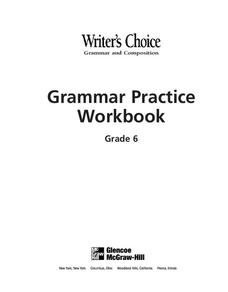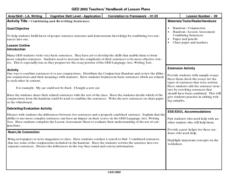Curated OER
Prepositional Phrases
What is a preposition? You can't possibly understand prepositional phrases without first learning prepositions. Start by reading the informative paragraph at the top of the page. An example is also included. This is a great introduction...
McGraw Hill
Grammar Practice Workbook
To an English teacher, the only sound worse than nails on a chalkboard is a student using improper grammar. Make poor grammar a problem of the past with this extensive collection of worksheets that covers...
Houghton Mifflin Harcourt
Kinds of Nouns
With so many different kinds of nouns, it can be hard for young learners to keep them all straight. Help clarify this important part of speech for your class with this series of worksheets which clearly addresses the difference...
Curated OER
Scrutinizing Stand-Ins: Working With Nouns and Pronouns
Use the Schoolhouse Rock episode, "Rufus Xavier Sarsaparilla," to introduce a study of pronouns. Learners consider antecedents, cases (nominative, objective and possessive), as well as types of pronouns, and then craft sentences using...
Scholastic
Subjects Meet Predicates
Inspire your pupils to really think about sentence subjects by asking them to puzzle out eight word puzzles to determine the subjects and then match them to the correct predicates. They then write three of their own complete sentences.
K12 Reader
Adjectives Describe
Vivid writers all start out the same way: learning in elementary school how to use a variety of adjectives! Young grammarians add adjectives to eight fill-in-the-blank sentences.
Vocabulary A-Z
5-Day Vocabulary Teaching Plan
Reinforce important reading skills with a set of vocabulary lesson plans. Middle schoolers complete sentences, play word games, finish analogies, and build their growing vocabulary with a packet of helpful and applicable graphic organizers.
K12 Reader
Writing with Interjections
Challenge young writers to craft original sentences using interjections from a list provided on a colorful worksheet.
Curated OER
Starters for 10
This presentation gives young writers ways to start sentences in interesting ways. They can use an adverb, an -ing clause, a simile, a connective, or a preposition. Learners make up sentences on the spot using each of these techniques.
Curated OER
She's = is or has?
Providing eleven sentences for English learners to review, this learning exercise focuses on defining the contractions in each sentence. Students choose the correct definition based on the context clues of the sentence. Contractions...
Curated OER
Subject-Verb Agreement: Irregular Verbs
Irregular verbs meet the final frontier in this subject-verb agreement activity! There are 12 sentences here missing an irregular verb which must agree with the subject or subjects. All sentences relate to space and even give some...
Curated OER
Common and Proper Nouns
Identify nouns in speech and writing. Learners find all the nouns in a read-aloud story. Then, they complete a worksheet that reviews the use of nouns, verbs, adjectives, prepositions, conjunctions, pronouns, and interjections. A list of...
Curated OER
Lie & Lay
When do you use "lie," and when do you use "lay"? Use this worksheet in your ESL class to find the difference. Ten questions provide sentences with blanks for English learners to complete with the two verbs, often in different tenses....
Curated OER
Subject-Verb Agreement
Subject-verb agreement takes practice to master; give your learners a chance to put their skills to the test using these 10 sentences. They choose the correct verb from two options for each sentence. Encourage subject recognition and not...
Curated OER
Subject-Verb Agreement
Simple yet useful, these sentences require scholars to fill in the verb that matches the subject for each. There are five sentences total, each with two verb options. The options require learners to choose whether they should incorporate...
Curated OER
Collective Nouns
Explore collective nouns with this worksheet. Learners discover what collective nouns are and describe groups of animals by using the word bank to fill in the blanks in 9 sentences. Class members are also encouraged to create their own...
Curated OER
Direct and Indirect Speech
The focus of this language arts worksheet are the differences between direct and indirect speech. Learners efer to a story and analyze examples of direct or indirect speech, note verb tense changes and converting five sentences.
Curated OER
Combining and Rewriting Sentences
Learners practice combining sentences using the conjunction handout provided. They search magazines and newspapers to identify combined sentences that use conjunctions. Finally, these are rewritten again as two separate sentences.
Curated OER
Indirect Object- Direct Object Recognition Practice
In this nouns in sentences worksheet, students first read about the difference between direct and indirect objects. Students read ten sentences and write down the indirect and the direct object.
Curated OER
Working with Tenses
Practice verb tense by filling in the blank. Learners evaluate the provided verb in the context of its sentence and then fill in the blank with the proper tense of that verb. There are 15 sentences to evaluate.
Curated OER
Verbs
Have your class practice using the verbs am, are, were, was, and is. Learners read sentences and identify the verbs in each sentence. This is a comprehensive exploration of this topic.
Curated OER
Adjectives - Describing Words
Here is a charming presentation on adjectives for young readers. Pupils consider sentences in each slide that have at least one adjective in them. They must find the adjective in each of the sentences and also the noun it describes. Good...
Curated OER
Worksheet 3/7 A Gaggle of Collective Nouns
Encourage your class to identify the correct usage of collective nouns in sentences with this activity. Given three choices, with the collective nouns circled in each possible choice, class members choose the sentence in which the...
Curated OER
Build Complex Sentences
Learners practice building complex sentences in this sentence combining-like exercise. Two simple sentences are given; your writers must make one reasonable complex sentence out of each pair using the conjunction provided. Ten examples...























